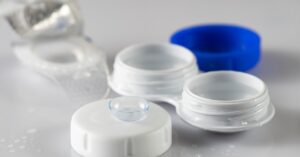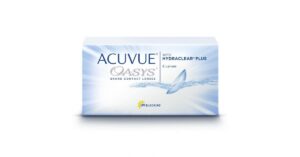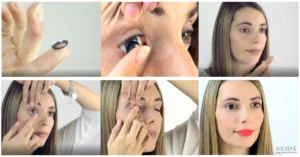Understanding Contact Lens Dryness
Contact lens dryness can be a frustrating and uncomfortable experience for contact lens wearers. To effectively address this issue, it is important to understand what causes contact lens dryness and recognize the symptoms associated with it.
What Causes Contact Lens Dryness?
Contact lens dryness can be attributed to several factors. One common cause is insufficient tear production. Tears play a vital role in keeping the eyes moist and comfortable, but some individuals may not produce enough tears to adequately lubricate the contact lenses. This can result in dryness and discomfort.
Another factor that contributes to contact lens dryness is evaporation. When wearing contact lenses, the lenses may hinder the natural evaporation of tears from the eyes, leading to dryness. This is especially common in environments with low humidity or when exposed to air conditioning or heating systems.
Certain environmental triggers can exacerbate contact lens dryness as well. Factors such as air pollution, smoke, wind, and dry climates can all contribute to the discomfort experienced by contact lens wearers. Additionally, prolonged exposure to digital screens and excessive screen time may contribute to dryness due to reduced blinking and increased evaporation.
Symptoms of Contact Lens Dryness
Recognizing the symptoms of contact lens dryness is crucial in addressing the issue promptly. Some common symptoms include:
- Dryness and discomfort: Contact lens wearers may experience a dry and gritty sensation in their eyes, making it uncomfortable to wear their lenses for extended periods.
- Redness and irritation: Dryness can cause redness, itchiness, and irritation in the eyes, leading to discomfort.
- Blurred vision: Dryness may result in blurry or hazy vision, affecting the clarity and sharpness of eyesight.
- Excessive tearing: Paradoxically, eyes may produce excessive tears as a response to dryness in an attempt to lubricate the eyes and contact lenses.
If you experience any of these symptoms, it is important to address them promptly to ensure eye health and comfort. Seeking professional advice from an eye care provider is essential for proper diagnosis and guidance on managing contact lens dryness. For more information on contact lens-related issues, you can refer to our articles on dry eye and contact lenses, dry eye syndrome and contact lenses, contact lens irritation, and contact lens intolerance.
Tips for Preventing Contact Lens Dryness
To alleviate contact lens dryness and ensure comfortable wearing experience, it’s important to adopt certain preventive measures. By practicing proper lens hygiene, avoiding environmental triggers, and using lubricating drops, you can help reduce the occurrence of dryness and discomfort associated with contact lens wear.
Proper Lens Hygiene
Maintaining proper lens hygiene is essential for preventing contact lens dryness. Follow these guidelines to ensure your lenses stay clean and comfortable:
- Wash your hands thoroughly with soap and water before handling your lenses.
- Cleanse your lenses using a recommended multipurpose contact lens solution. Gently rub the lenses with your fingers to remove any debris or protein buildup.
- Rinse your lenses with the solution to remove any loosened debris.
- Store your lenses in a clean case filled with fresh solution when not in use. Replace the solution regularly and clean the case frequently to prevent contamination.
- Avoid reusing solution from the previous day. Always use fresh solution to store and rinse your lenses.
By following these hygiene practices, you can minimize the risk of debris and irritants accumulating on your lenses, which can contribute to dryness and discomfort.
Avoiding Environmental Triggers
Environmental factors can play a significant role in contact lens dryness. Consider these tips to minimize exposure to triggers:
- Limit your exposure to dry environments, such as air-conditioned rooms or windy outdoor areas, as they can contribute to lens dryness. Use a humidifier in dry indoor environments to add moisture to the air.
- Protect your eyes from irritants like smoke, dust, and pollen. Consider wearing sunglasses to shield your eyes from wind and sun exposure.
- Avoid prolonged use of digital devices as it can contribute to dryness and eye fatigue. Take regular breaks, blink frequently, and follow the 20-20-20 rule—look away from the screen every 20 minutes and focus on something at least 20 feet away for 20 seconds.
By being mindful of your environment and taking steps to reduce exposure to drying factors, you can help maintain comfortable contact lens wear.
Using Lubricating Drops
Lubricating eye drops can provide temporary relief from contact lens dryness. These drops work by adding moisture to the eyes and lubricating the lens surface. When choosing lubricating drops, opt for products specifically formulated for use with contact lenses.
Before using lubricating drops, ensure you’re following the instructions provided by your eye care professional or the product packaging. Apply the drops as directed, either before or after inserting your lenses, to help alleviate dryness and improve lens comfort.
Remember, if you experience persistent dryness or discomfort despite employing these preventive measures, it’s important to consult with an eye care professional. They can assess your condition and provide further guidance on managing contact lens dryness. For more information on dry eye and contact lenses, check out our article on dry eye and contact lenses.
By incorporating these prevention tips into your contact lens routine, you can minimize the discomfort associated with dryness and enjoy comfortable and clear vision throughout the day.
Choosing the Right Contact Lenses
When it comes to dealing with contact lens dryness, selecting the right type of contact lenses can make a significant difference in your comfort and overall experience. There are various considerations to keep in mind when choosing contact lenses, as well as different types available to meet your specific needs.
Considerations for Lens Selection
When selecting contact lenses, it’s important to consider factors that can contribute to dryness. These factors include the material of the lenses, the water content, and the breathability. Here are some key considerations to keep in mind:
- Material: Contact lenses are typically made from different materials, such as silicone hydrogel or hydrogel. Silicone hydrogel lenses tend to be more breathable and retain moisture better, making them a suitable option for individuals prone to dryness.
- Water content: The water content of contact lenses can affect how well they retain moisture. Higher water content lenses may be more comfortable for those with dry eyes, as they can provide better hydration. However, it’s important to note that high water content lenses may be more prone to dehydration in certain environments.
- Breathability: The oxygen permeability of contact lenses is crucial for maintaining eye health. Lenses that allow sufficient oxygen to reach the cornea promote better tear film stability and reduce the risk of dryness.
Considering these factors and discussing them with your eye care professional can help you choose contact lenses that are better suited to your individual needs. Your eye care professional can provide guidance based on your specific dry eye condition. For more information on dry eyes and contact lenses, visit our article on dry eye and contact lenses.
Different Types of Contact Lenses
There are several types of contact lenses available, each with its own unique characteristics. Here are some common types of contact lenses:
| Type of Contact Lens | Description |
|---|---|
| Daily Disposable | These lenses are worn once and then discarded. They eliminate the need for cleaning and storage, which can be beneficial for individuals with dry eyes who may be more susceptible to irritation. Daily disposable lenses also provide a fresh and hydrated lens surface with every wear. |
| Monthly or Extended Wear | These lenses are designed to be worn continuously for up to a month before replacement. They offer convenience, but it’s important to note that extended wear lenses may require more diligent cleaning and maintenance to prevent dryness and potential complications. |
| Toric | Toric lenses are specifically designed to correct astigmatism. They are available in various wearing schedules, including daily disposable and monthly options. It’s important to choose toric lenses that incorporate features to enhance tear stability and minimize dryness for individuals with astigmatism. |
| Multifocal | Multifocal lenses are intended for individuals with presbyopia, a condition that affects near vision. These lenses provide multiple focal points to address both near and distance vision. It’s crucial to select multifocal lenses that prioritize moisture retention and comfort to alleviate dryness. |
Remember, it’s essential to consult with your eye care professional to determine the most suitable contact lenses for your specific needs. Regular check-ups and open communication with your eye care professional can help address any concerns related to contact lens dryness and ensure optimal eye health. If you’re experiencing irritation or discomfort with your contact lenses, it’s important to seek professional advice to rule out any underlying issues. For more information on common contact lens problems, visit our article on contact lens problems.
Managing Contact Lens Dryness
For individuals experiencing contact lens dryness, there are several strategies that can help alleviate this discomfort and allow for more comfortable lens wear. Below are some effective management techniques to consider.
Blinking Exercises
Blinking exercises can help combat contact lens dryness by promoting tear production and maintaining moisture on the ocular surface. These exercises involve consciously blinking your eyes at regular intervals, especially during tasks that require prolonged visual focus, such as working on a computer or reading. By doing so, you can prevent your eyes from becoming dry and help distribute tears evenly over the surface of your eyes.
To perform blinking exercises, simply take a moment to consciously blink your eyes slowly and fully. You can also try the 20-20-20 rule: every 20 minutes, take a 20-second break to focus on an object 20 feet away while blinking frequently. These exercises can be incorporated into your daily routine to provide relief from contact lens dryness.
Adjusting Lens Wear Schedule
Another strategy to manage contact lens dryness is to adjust your lens wear schedule. If you experience discomfort and dryness while wearing your lenses for extended periods, it may be helpful to reduce the number of hours you wear them each day. Additionally, you can try taking short breaks from wearing your lenses throughout the day to allow your eyes to rest and replenish their natural moisture.
It’s important to follow the recommendations provided by your eye care professional regarding lens wear time and replacement schedule. Adhering to proper lens hygiene practices, such as cleaning and disinfecting your lenses regularly, can also help prevent contact lens-related dryness. If you’re unsure about the appropriate wear schedule for your lenses, seek guidance from your eye care provider.
Seeking Professional Advice
If you continue to experience persistent contact lens dryness despite trying various self-management techniques, it’s advisable to seek professional advice from an eye care specialist. They can evaluate your condition, assess the fit and type of lenses you are using, and provide personalized recommendations to address your specific needs.
An eye care professional may suggest switching to different lens materials or designs that are more suitable for individuals with dry eyes. They can also evaluate whether an underlying condition, such as dry eye syndrome, is contributing to your discomfort. For more information about the relationship between dry eye syndrome and contact lenses, check out our article on dry eye syndrome and contact lenses.
Remember, contact lens dryness can be a common issue for many wearers, but it’s important to address it promptly to avoid further complications or discomfort. By incorporating these management techniques, you can enhance your comfort and extend your wearing time while enjoying the benefits of contact lenses.
Lifestyle Changes to Alleviate Dryness
In addition to proper lens care and management, making certain lifestyle changes can help alleviate contact lens dryness. By incorporating these habits into your daily routine, you can improve the comfort and overall health of your eyes.
Hydration and Diet
Staying hydrated is essential for maintaining healthy eyes and minimizing contact lens dryness. Make sure to drink plenty of water throughout the day, as dehydration can contribute to dryness. Additionally, a balanced diet rich in omega-3 fatty acids, vitamins, and minerals can support eye health. Foods such as fish, leafy greens, citrus fruits, and nuts are known to be beneficial for eye hydration and overall eye health.
Here are some key nutrients that promote eye health:
| Nutrient | Food Sources |
|---|---|
| Omega-3 fatty acids | Salmon, walnuts, flaxseeds |
| Vitamin C | Oranges, strawberries, bell peppers |
| Vitamin E | Almonds, spinach, sunflower seeds |
| Zinc | Beef, pumpkin seeds, chickpeas |
Limiting Screen Time
Excessive screen time can contribute to eye dryness and discomfort, as it can lead to decreased blinking and increased evaporation of tears. To help alleviate contact lens dryness, it’s important to take regular breaks from digital devices. Follow the 20-20-20 rule: every 20 minutes, look at something 20 feet away for 20 seconds. This helps relax your eye muscles and promotes natural blinking, which can prevent dryness.
Protecting Your Eyes from Irritants
Protecting your eyes from irritants is crucial in managing contact lens dryness. Environmental factors such as smoke, dust, and air pollution can worsen dryness symptoms. Consider wearing wraparound sunglasses or goggles in windy or dusty environments to shield your eyes from these irritants. Additionally, avoid rubbing your eyes, as this can further exacerbate dryness and potentially cause irritation.
By implementing these lifestyle changes into your daily routine, you can help alleviate contact lens dryness and improve the overall comfort of wearing your lenses. Remember to stay hydrated, maintain a balanced diet, limit screen time, and protect your eyes from irritants. If you continue to experience persistent dryness despite these lifestyle changes, it is advisable to seek professional advice from an eye care specialist. For more information on managing dry eye syndrome, check out our article on dry eye and contact lenses.
























